Accounting Case Study: Cost-Volume-Profit Analysis and Decision Making
VerifiedAdded on 2023/06/15
|15
|2324
|372
Case Study
AI Summary
This assignment presents a detailed solution to three case studies related to managerial accounting. The first case study involves estimating the contribution to a charity event by analyzing variable and fixed costs using the high-low method, and determining the optimal bidding strategy for a catering contract. The second case study focuses on break-even analysis, contribution margin calculations, and deciding between hiring an internal sales force versus external agents based on profitability. The third case study examines the impact of acquiring an automated milling machine on overhead rates, product costs, and the accuracy of cost savings calculations, revealing potential errors in initial assessments and the consequences of increased overhead costs. The document is available on Desklib, a platform offering a range of study tools and solved assignments for students.
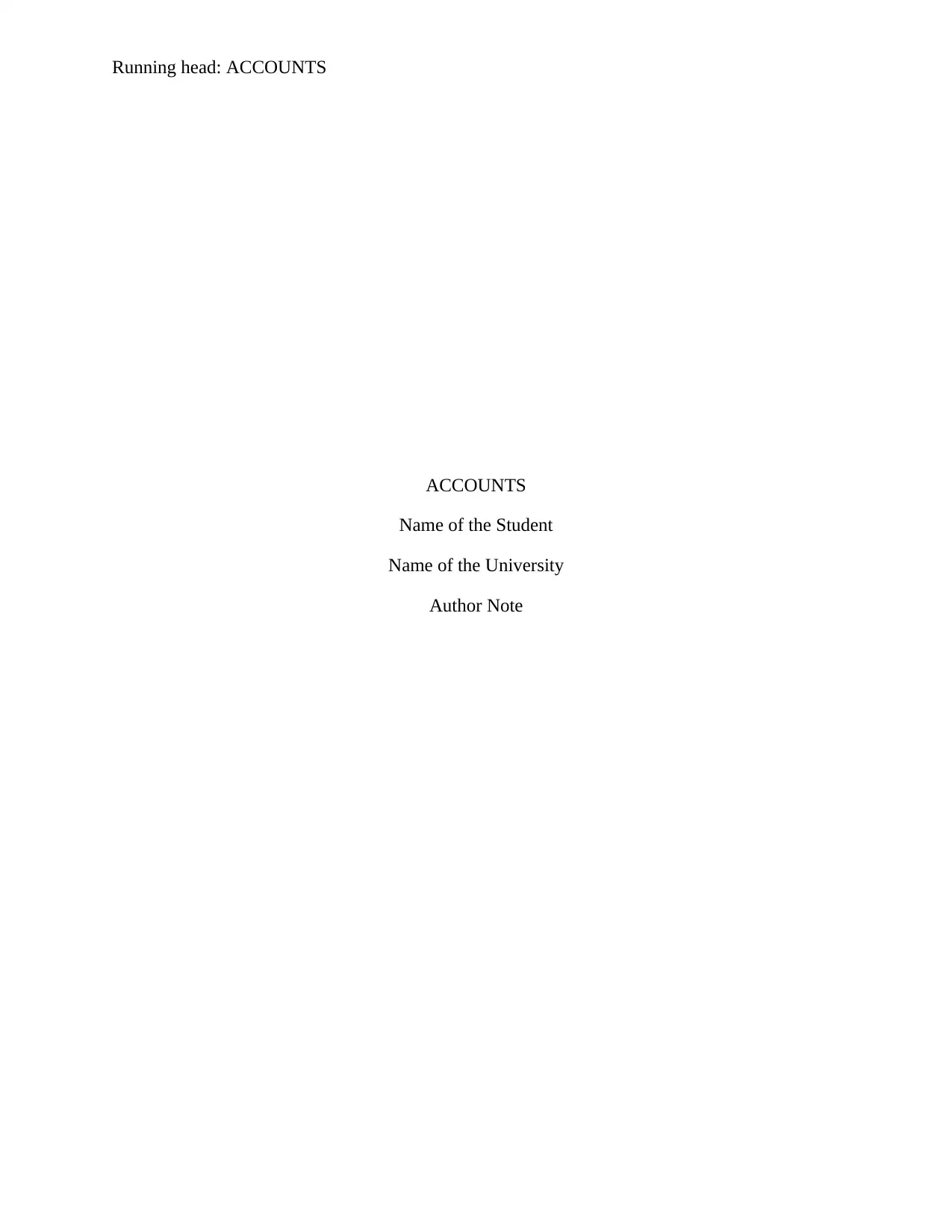
Running head: ACCOUNTS
ACCOUNTS
Name of the Student
Name of the University
Author Note
ACCOUNTS
Name of the Student
Name of the University
Author Note
Paraphrase This Document
Need a fresh take? Get an instant paraphrase of this document with our AI Paraphraser
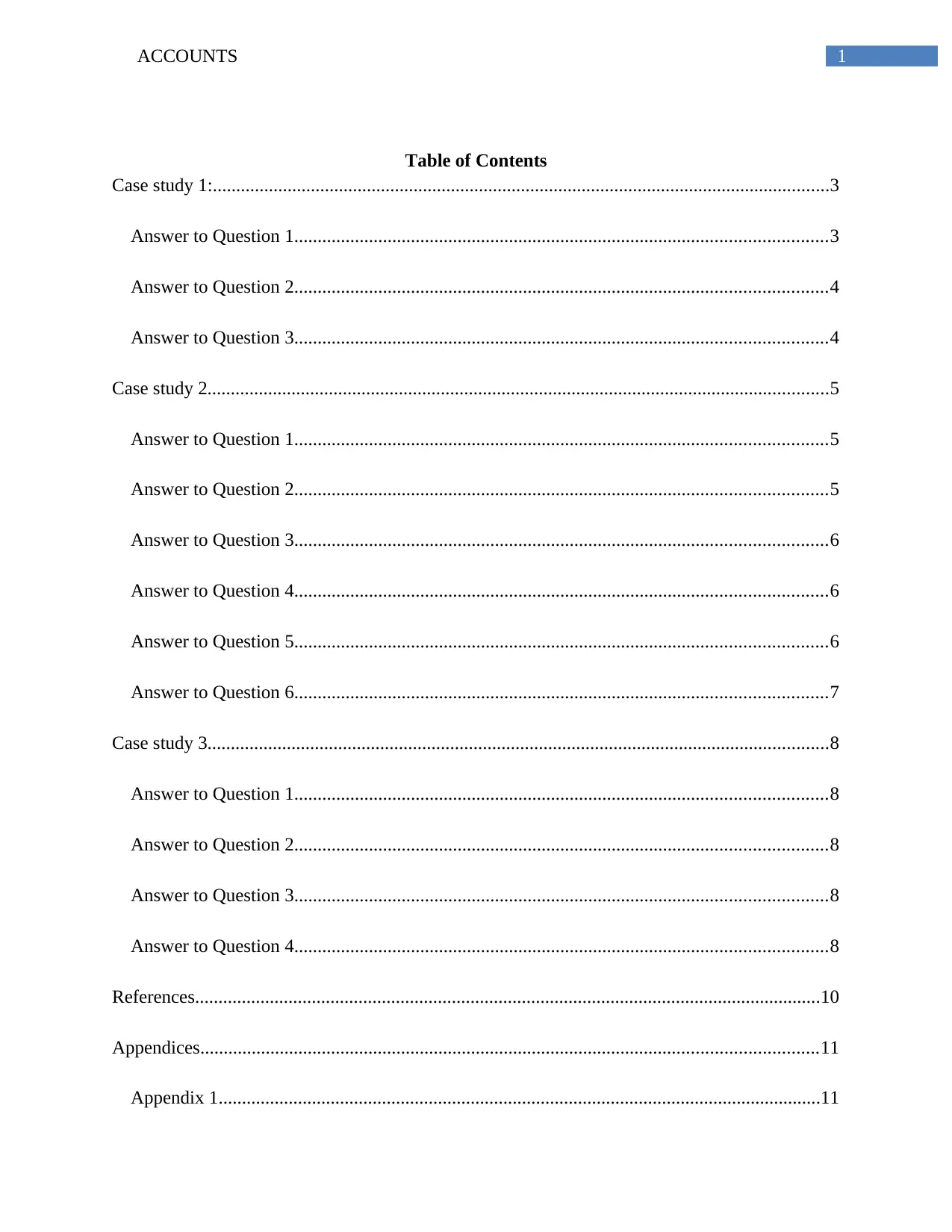
1ACCOUNTS
Table of Contents
Case study 1:....................................................................................................................................3
Answer to Question 1..................................................................................................................3
Answer to Question 2..................................................................................................................4
Answer to Question 3..................................................................................................................4
Case study 2.....................................................................................................................................5
Answer to Question 1..................................................................................................................5
Answer to Question 2..................................................................................................................5
Answer to Question 3..................................................................................................................6
Answer to Question 4..................................................................................................................6
Answer to Question 5..................................................................................................................6
Answer to Question 6..................................................................................................................7
Case study 3.....................................................................................................................................8
Answer to Question 1..................................................................................................................8
Answer to Question 2..................................................................................................................8
Answer to Question 3..................................................................................................................8
Answer to Question 4..................................................................................................................8
References......................................................................................................................................10
Appendices....................................................................................................................................11
Appendix 1.................................................................................................................................11
Table of Contents
Case study 1:....................................................................................................................................3
Answer to Question 1..................................................................................................................3
Answer to Question 2..................................................................................................................4
Answer to Question 3..................................................................................................................4
Case study 2.....................................................................................................................................5
Answer to Question 1..................................................................................................................5
Answer to Question 2..................................................................................................................5
Answer to Question 3..................................................................................................................6
Answer to Question 4..................................................................................................................6
Answer to Question 5..................................................................................................................6
Answer to Question 6..................................................................................................................7
Case study 3.....................................................................................................................................8
Answer to Question 1..................................................................................................................8
Answer to Question 2..................................................................................................................8
Answer to Question 3..................................................................................................................8
Answer to Question 4..................................................................................................................8
References......................................................................................................................................10
Appendices....................................................................................................................................11
Appendix 1.................................................................................................................................11
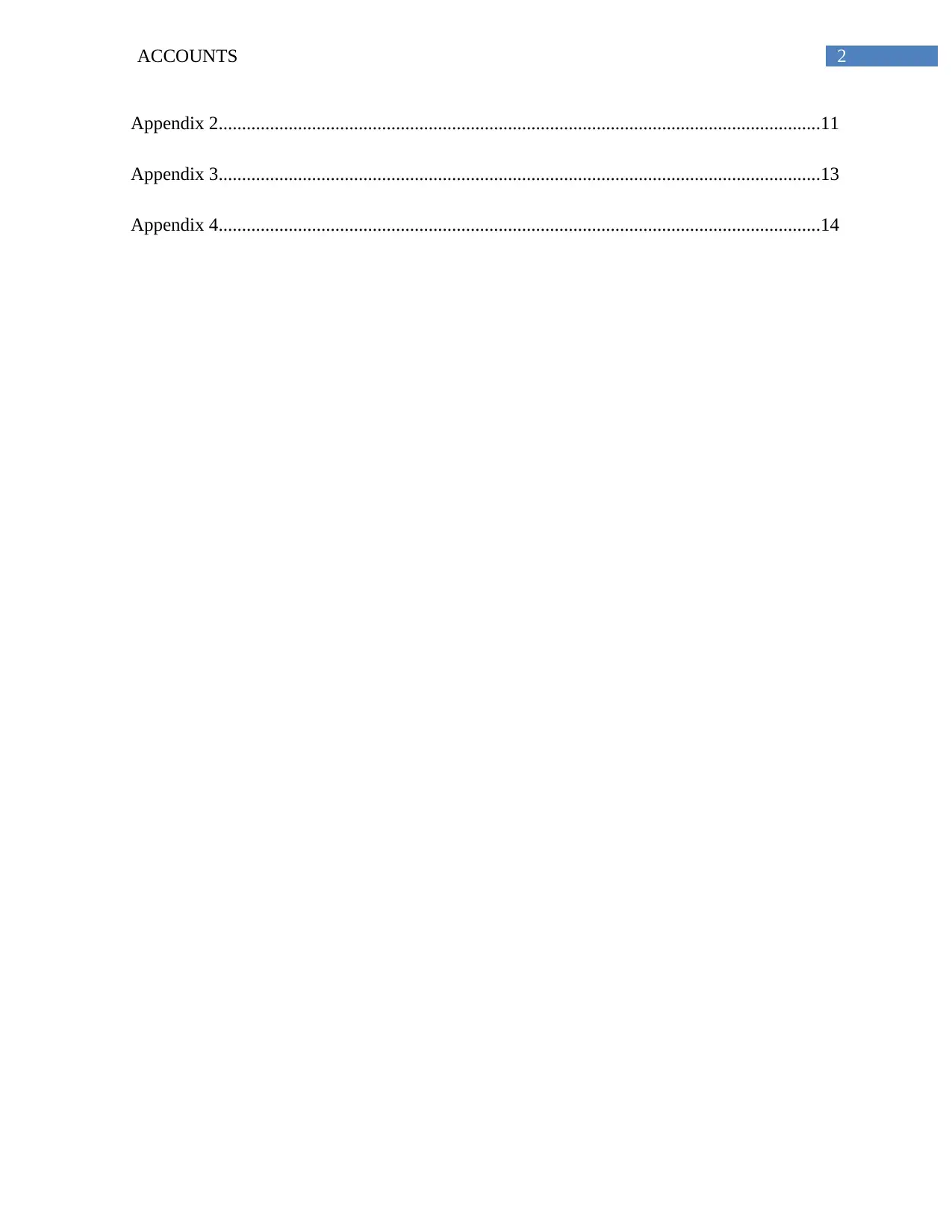
2ACCOUNTS
Appendix 2.................................................................................................................................11
Appendix 3.................................................................................................................................13
Appendix 4.................................................................................................................................14
Appendix 2.................................................................................................................................11
Appendix 3.................................................................................................................................13
Appendix 4.................................................................................................................................14
⊘ This is a preview!⊘
Do you want full access?
Subscribe today to unlock all pages.

Trusted by 1+ million students worldwide
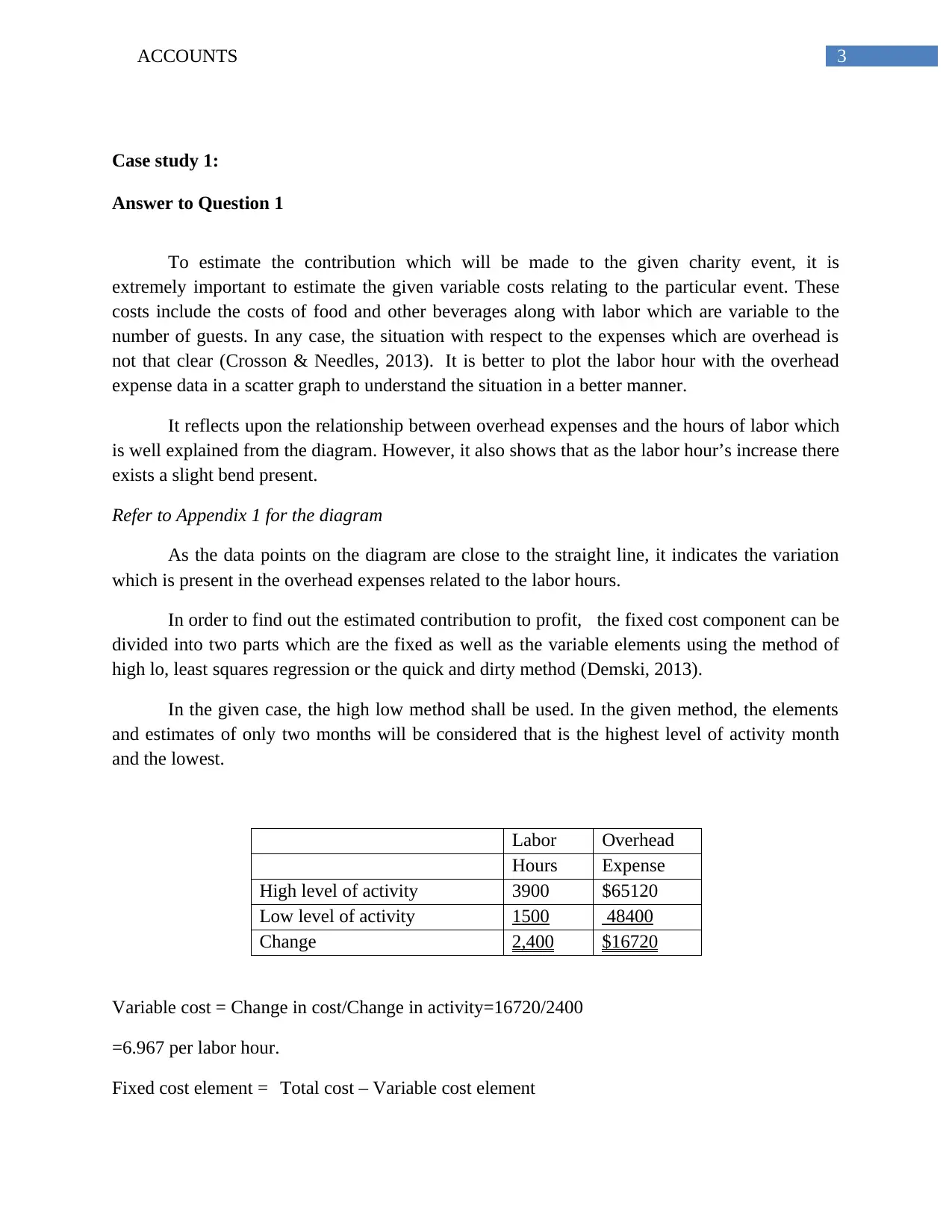
3ACCOUNTS
Case study 1:
Answer to Question 1
To estimate the contribution which will be made to the given charity event, it is
extremely important to estimate the given variable costs relating to the particular event. These
costs include the costs of food and other beverages along with labor which are variable to the
number of guests. In any case, the situation with respect to the expenses which are overhead is
not that clear (Crosson & Needles, 2013). It is better to plot the labor hour with the overhead
expense data in a scatter graph to understand the situation in a better manner.
It reflects upon the relationship between overhead expenses and the hours of labor which
is well explained from the diagram. However, it also shows that as the labor hour’s increase there
exists a slight bend present.
Refer to Appendix 1 for the diagram
As the data points on the diagram are close to the straight line, it indicates the variation
which is present in the overhead expenses related to the labor hours.
In order to find out the estimated contribution to profit, the fixed cost component can be
divided into two parts which are the fixed as well as the variable elements using the method of
high lo, least squares regression or the quick and dirty method (Demski, 2013).
In the given case, the high low method shall be used. In the given method, the elements
and estimates of only two months will be considered that is the highest level of activity month
and the lowest.
Labor Overhead
Hours Expense
High level of activity 3900 $65120
Low level of activity 1500 48400
Change 2,400 $16720
Variable cost = Change in cost/Change in activity=16720/2400
=6.967 per labor hour.
Fixed cost element = Total cost – Variable cost element
Case study 1:
Answer to Question 1
To estimate the contribution which will be made to the given charity event, it is
extremely important to estimate the given variable costs relating to the particular event. These
costs include the costs of food and other beverages along with labor which are variable to the
number of guests. In any case, the situation with respect to the expenses which are overhead is
not that clear (Crosson & Needles, 2013). It is better to plot the labor hour with the overhead
expense data in a scatter graph to understand the situation in a better manner.
It reflects upon the relationship between overhead expenses and the hours of labor which
is well explained from the diagram. However, it also shows that as the labor hour’s increase there
exists a slight bend present.
Refer to Appendix 1 for the diagram
As the data points on the diagram are close to the straight line, it indicates the variation
which is present in the overhead expenses related to the labor hours.
In order to find out the estimated contribution to profit, the fixed cost component can be
divided into two parts which are the fixed as well as the variable elements using the method of
high lo, least squares regression or the quick and dirty method (Demski, 2013).
In the given case, the high low method shall be used. In the given method, the elements
and estimates of only two months will be considered that is the highest level of activity month
and the lowest.
Labor Overhead
Hours Expense
High level of activity 3900 $65120
Low level of activity 1500 48400
Change 2,400 $16720
Variable cost = Change in cost/Change in activity=16720/2400
=6.967 per labor hour.
Fixed cost element = Total cost – Variable cost element
Paraphrase This Document
Need a fresh take? Get an instant paraphrase of this document with our AI Paraphraser
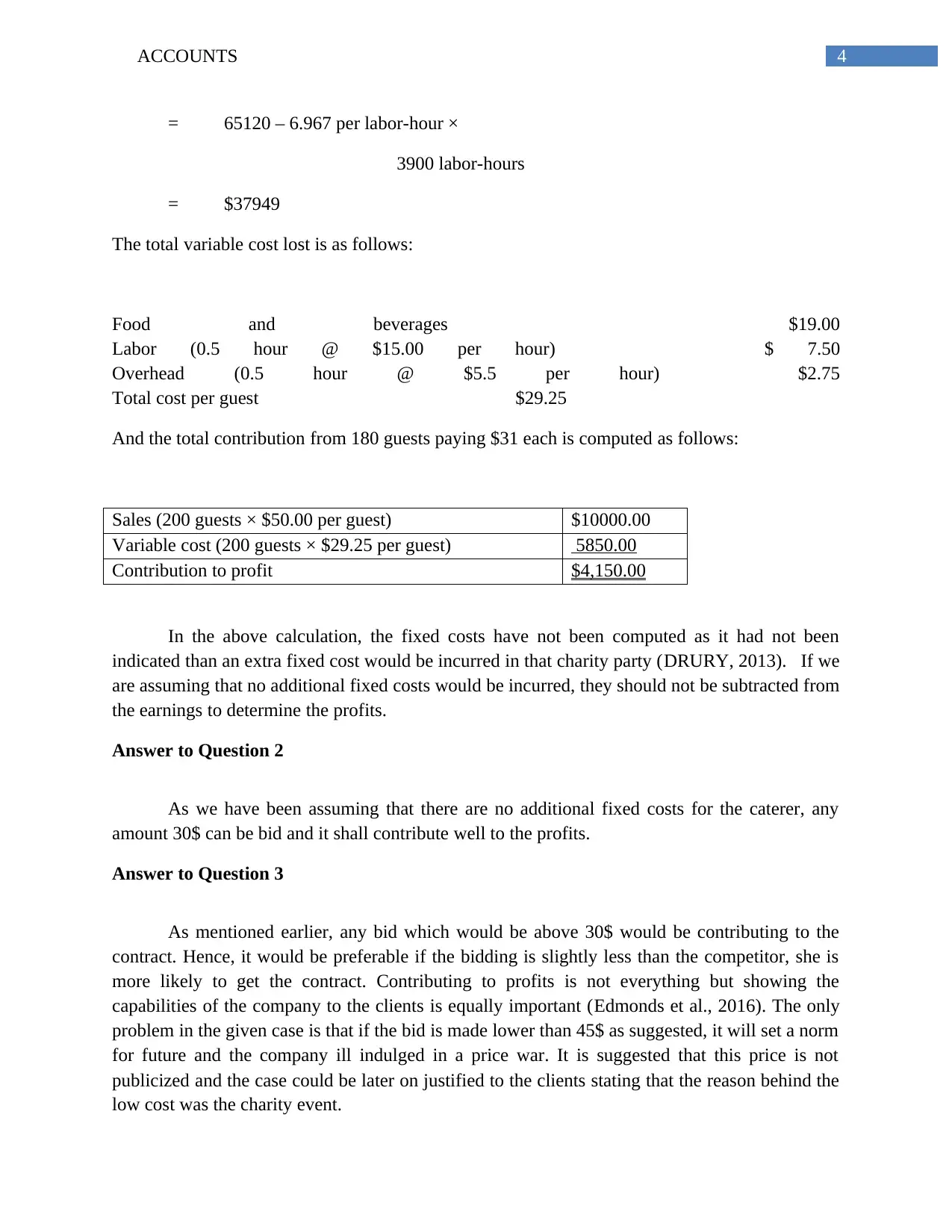
4ACCOUNTS
= 65120 – 6.967 per labor-hour ×
3900 labor-hours
= $37949
The total variable cost lost is as follows:
Food and beverages $19.00
Labor (0.5 hour @ $15.00 per hour) $ 7.50
Overhead (0.5 hour @ $5.5 per hour) $2.75
Total cost per guest $29.25
And the total contribution from 180 guests paying $31 each is computed as follows:
Sales (200 guests × $50.00 per guest) $10000.00
Variable cost (200 guests × $29.25 per guest) 5850.00
Contribution to profit $4,150.00
In the above calculation, the fixed costs have not been computed as it had not been
indicated than an extra fixed cost would be incurred in that charity party (DRURY, 2013). If we
are assuming that no additional fixed costs would be incurred, they should not be subtracted from
the earnings to determine the profits.
Answer to Question 2
As we have been assuming that there are no additional fixed costs for the caterer, any
amount 30$ can be bid and it shall contribute well to the profits.
Answer to Question 3
As mentioned earlier, any bid which would be above 30$ would be contributing to the
contract. Hence, it would be preferable if the bidding is slightly less than the competitor, she is
more likely to get the contract. Contributing to profits is not everything but showing the
capabilities of the company to the clients is equally important (Edmonds et al., 2016). The only
problem in the given case is that if the bid is made lower than 45$ as suggested, it will set a norm
for future and the company ill indulged in a price war. It is suggested that this price is not
publicized and the case could be later on justified to the clients stating that the reason behind the
low cost was the charity event.
= 65120 – 6.967 per labor-hour ×
3900 labor-hours
= $37949
The total variable cost lost is as follows:
Food and beverages $19.00
Labor (0.5 hour @ $15.00 per hour) $ 7.50
Overhead (0.5 hour @ $5.5 per hour) $2.75
Total cost per guest $29.25
And the total contribution from 180 guests paying $31 each is computed as follows:
Sales (200 guests × $50.00 per guest) $10000.00
Variable cost (200 guests × $29.25 per guest) 5850.00
Contribution to profit $4,150.00
In the above calculation, the fixed costs have not been computed as it had not been
indicated than an extra fixed cost would be incurred in that charity party (DRURY, 2013). If we
are assuming that no additional fixed costs would be incurred, they should not be subtracted from
the earnings to determine the profits.
Answer to Question 2
As we have been assuming that there are no additional fixed costs for the caterer, any
amount 30$ can be bid and it shall contribute well to the profits.
Answer to Question 3
As mentioned earlier, any bid which would be above 30$ would be contributing to the
contract. Hence, it would be preferable if the bidding is slightly less than the competitor, she is
more likely to get the contract. Contributing to profits is not everything but showing the
capabilities of the company to the clients is equally important (Edmonds et al., 2016). The only
problem in the given case is that if the bid is made lower than 45$ as suggested, it will set a norm
for future and the company ill indulged in a price war. It is suggested that this price is not
publicized and the case could be later on justified to the clients stating that the reason behind the
low cost was the charity event.
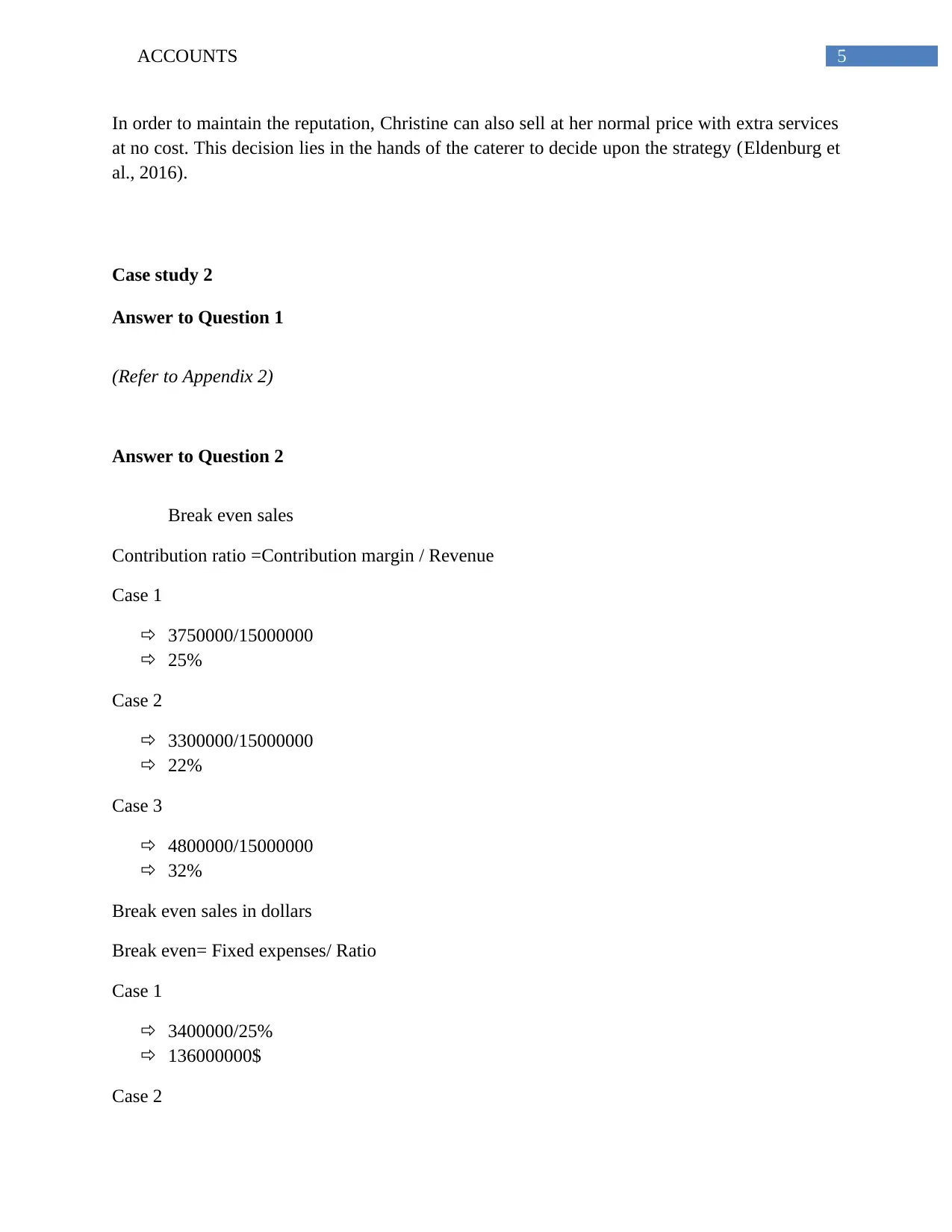
5ACCOUNTS
In order to maintain the reputation, Christine can also sell at her normal price with extra services
at no cost. This decision lies in the hands of the caterer to decide upon the strategy (Eldenburg et
al., 2016).
Case study 2
Answer to Question 1
(Refer to Appendix 2)
Answer to Question 2
Break even sales
Contribution ratio =Contribution margin / Revenue
Case 1
3750000/15000000
25%
Case 2
3300000/15000000
22%
Case 3
4800000/15000000
32%
Break even sales in dollars
Break even= Fixed expenses/ Ratio
Case 1
3400000/25%
136000000$
Case 2
In order to maintain the reputation, Christine can also sell at her normal price with extra services
at no cost. This decision lies in the hands of the caterer to decide upon the strategy (Eldenburg et
al., 2016).
Case study 2
Answer to Question 1
(Refer to Appendix 2)
Answer to Question 2
Break even sales
Contribution ratio =Contribution margin / Revenue
Case 1
3750000/15000000
25%
Case 2
3300000/15000000
22%
Case 3
4800000/15000000
32%
Break even sales in dollars
Break even= Fixed expenses/ Ratio
Case 1
3400000/25%
136000000$
Case 2
⊘ This is a preview!⊘
Do you want full access?
Subscribe today to unlock all pages.

Trusted by 1+ million students worldwide
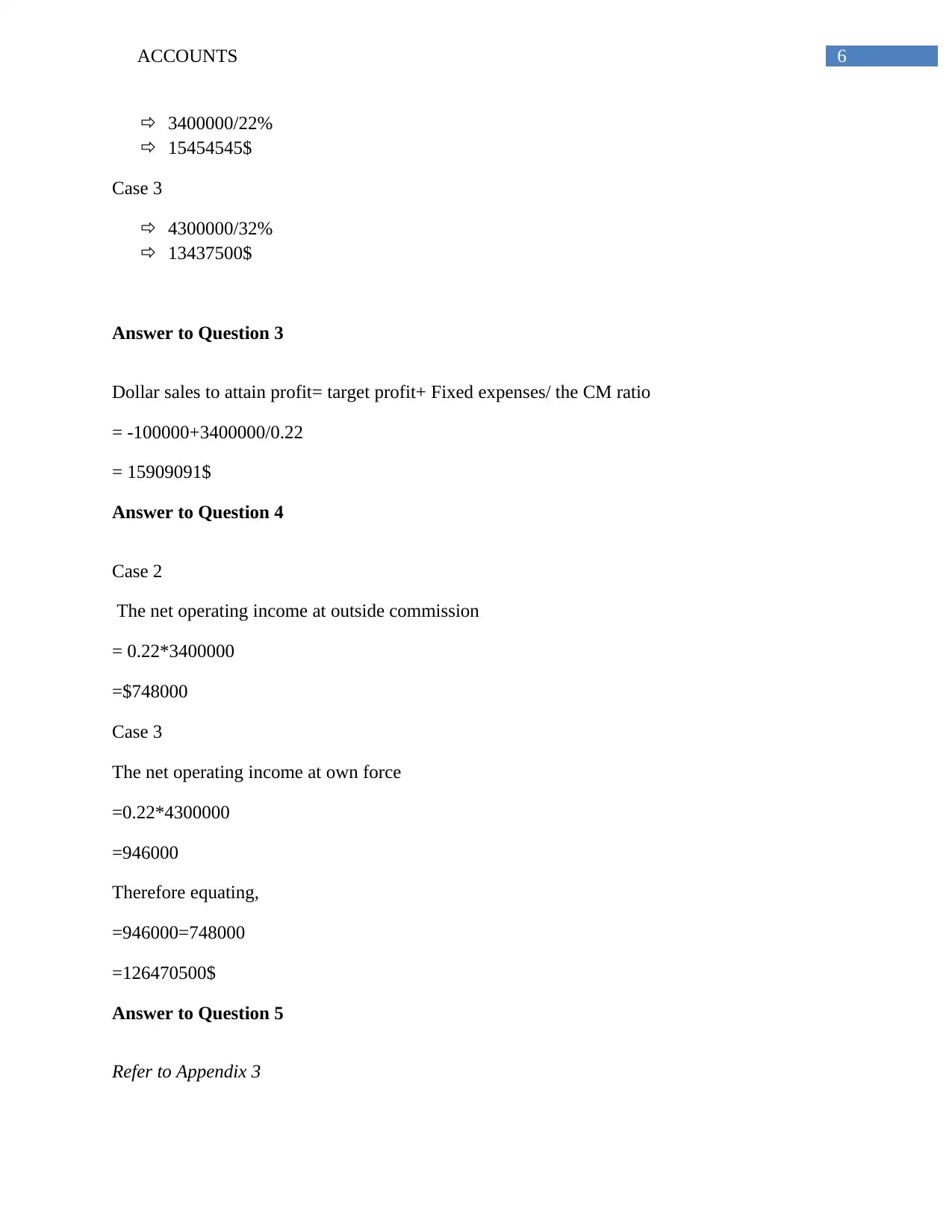
6ACCOUNTS
3400000/22%
15454545$
Case 3
4300000/32%
13437500$
Answer to Question 3
Dollar sales to attain profit= target profit+ Fixed expenses/ the CM ratio
= -100000+3400000/0.22
= 15909091$
Answer to Question 4
Case 2
The net operating income at outside commission
= 0.22*3400000
=$748000
Case 3
The net operating income at own force
=0.22*4300000
=946000
Therefore equating,
=946000=748000
=126470500$
Answer to Question 5
Refer to Appendix 3
3400000/22%
15454545$
Case 3
4300000/32%
13437500$
Answer to Question 3
Dollar sales to attain profit= target profit+ Fixed expenses/ the CM ratio
= -100000+3400000/0.22
= 15909091$
Answer to Question 4
Case 2
The net operating income at outside commission
= 0.22*3400000
=$748000
Case 3
The net operating income at own force
=0.22*4300000
=946000
Therefore equating,
=946000=748000
=126470500$
Answer to Question 5
Refer to Appendix 3
Paraphrase This Document
Need a fresh take? Get an instant paraphrase of this document with our AI Paraphraser
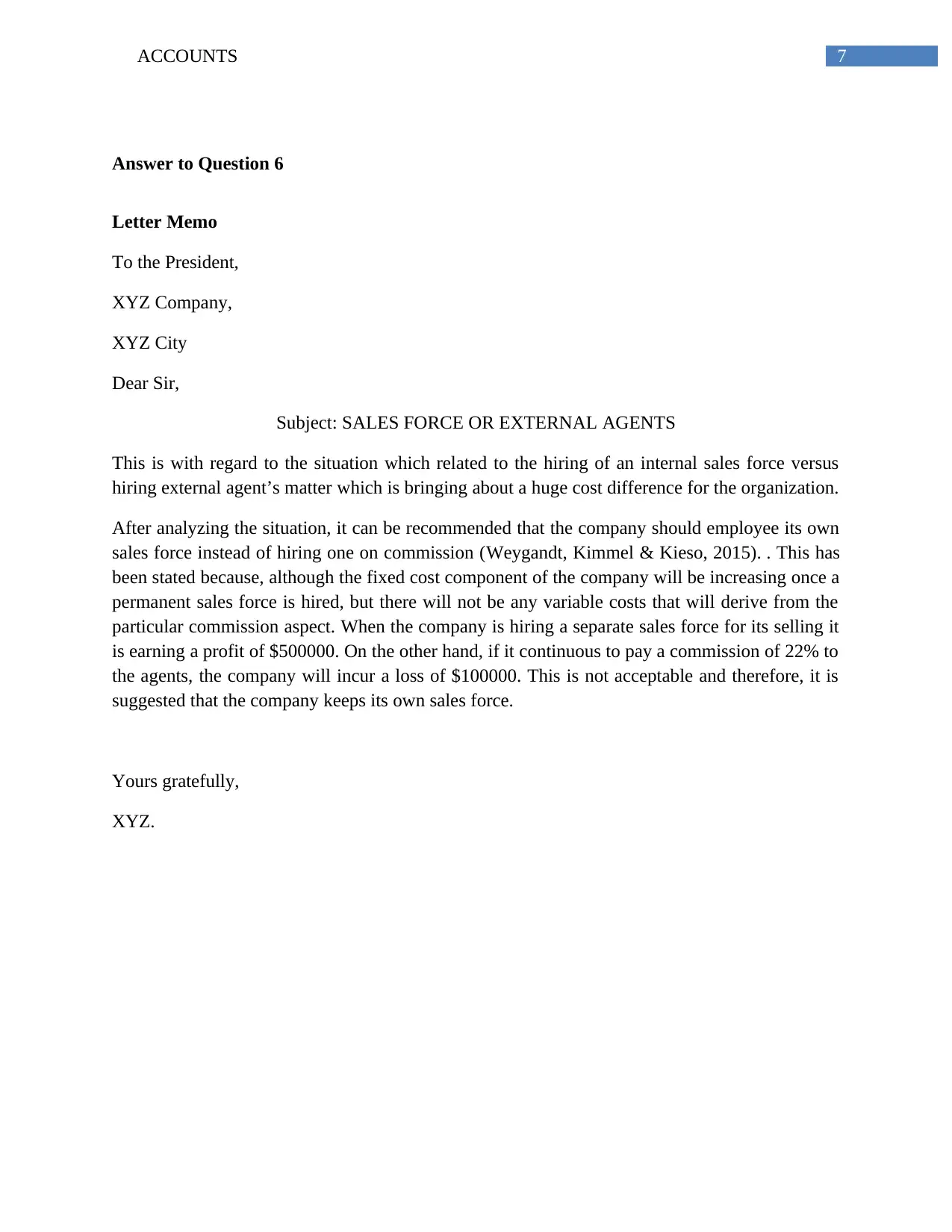
7ACCOUNTS
Answer to Question 6
Letter Memo
To the President,
XYZ Company,
XYZ City
Dear Sir,
Subject: SALES FORCE OR EXTERNAL AGENTS
This is with regard to the situation which related to the hiring of an internal sales force versus
hiring external agent’s matter which is bringing about a huge cost difference for the organization.
After analyzing the situation, it can be recommended that the company should employee its own
sales force instead of hiring one on commission (Weygandt, Kimmel & Kieso, 2015). . This has
been stated because, although the fixed cost component of the company will be increasing once a
permanent sales force is hired, but there will not be any variable costs that will derive from the
particular commission aspect. When the company is hiring a separate sales force for its selling it
is earning a profit of $500000. On the other hand, if it continuous to pay a commission of 22% to
the agents, the company will incur a loss of $100000. This is not acceptable and therefore, it is
suggested that the company keeps its own sales force.
Yours gratefully,
XYZ.
Answer to Question 6
Letter Memo
To the President,
XYZ Company,
XYZ City
Dear Sir,
Subject: SALES FORCE OR EXTERNAL AGENTS
This is with regard to the situation which related to the hiring of an internal sales force versus
hiring external agent’s matter which is bringing about a huge cost difference for the organization.
After analyzing the situation, it can be recommended that the company should employee its own
sales force instead of hiring one on commission (Weygandt, Kimmel & Kieso, 2015). . This has
been stated because, although the fixed cost component of the company will be increasing once a
permanent sales force is hired, but there will not be any variable costs that will derive from the
particular commission aspect. When the company is hiring a separate sales force for its selling it
is earning a profit of $500000. On the other hand, if it continuous to pay a commission of 22% to
the agents, the company will incur a loss of $100000. This is not acceptable and therefore, it is
suggested that the company keeps its own sales force.
Yours gratefully,
XYZ.
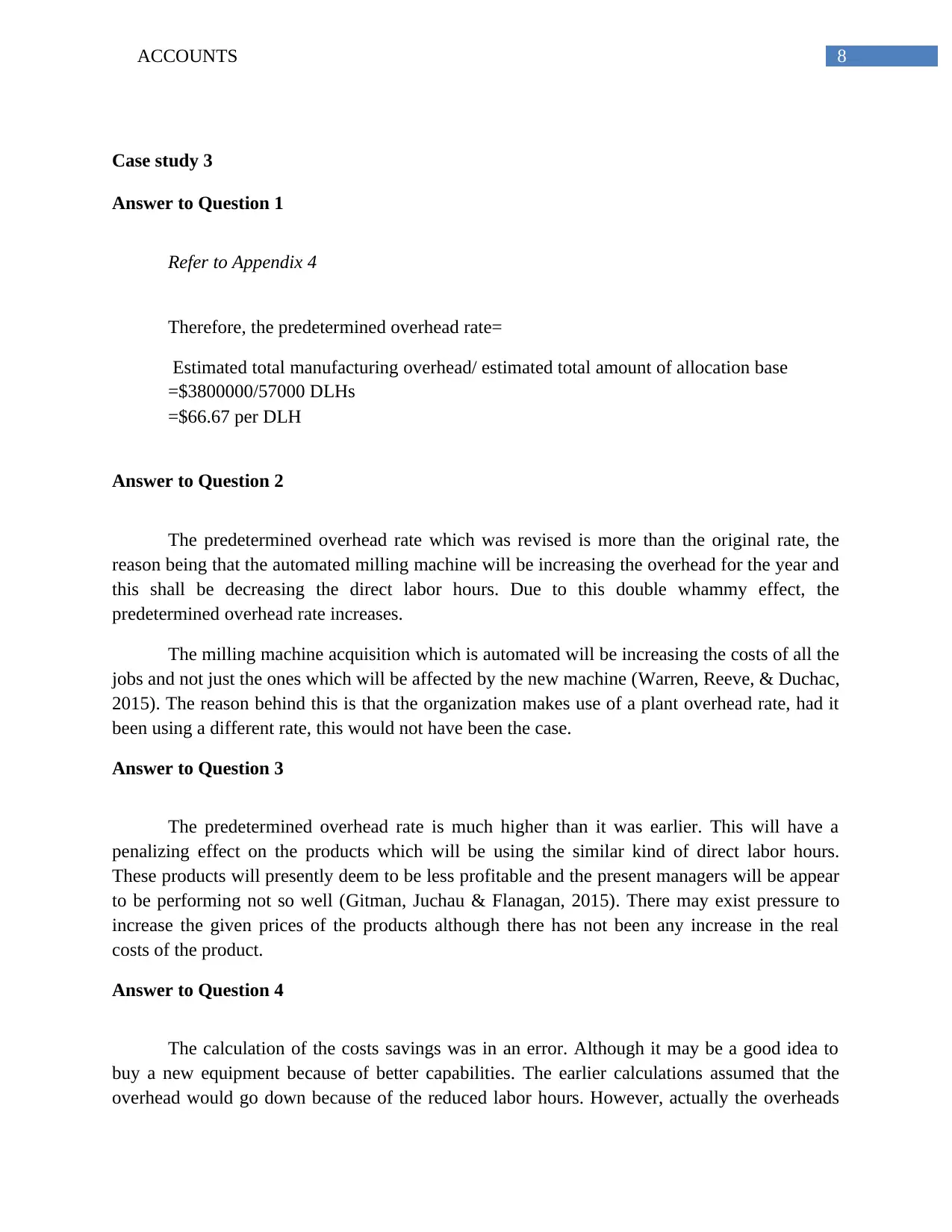
8ACCOUNTS
Case study 3
Answer to Question 1
Refer to Appendix 4
Therefore, the predetermined overhead rate=
Estimated total manufacturing overhead/ estimated total amount of allocation base
=$3800000/57000 DLHs
=$66.67 per DLH
Answer to Question 2
The predetermined overhead rate which was revised is more than the original rate, the
reason being that the automated milling machine will be increasing the overhead for the year and
this shall be decreasing the direct labor hours. Due to this double whammy effect, the
predetermined overhead rate increases.
The milling machine acquisition which is automated will be increasing the costs of all the
jobs and not just the ones which will be affected by the new machine (Warren, Reeve, & Duchac,
2015). The reason behind this is that the organization makes use of a plant overhead rate, had it
been using a different rate, this would not have been the case.
Answer to Question 3
The predetermined overhead rate is much higher than it was earlier. This will have a
penalizing effect on the products which will be using the similar kind of direct labor hours.
These products will presently deem to be less profitable and the present managers will be appear
to be performing not so well (Gitman, Juchau & Flanagan, 2015). There may exist pressure to
increase the given prices of the products although there has not been any increase in the real
costs of the product.
Answer to Question 4
The calculation of the costs savings was in an error. Although it may be a good idea to
buy a new equipment because of better capabilities. The earlier calculations assumed that the
overhead would go down because of the reduced labor hours. However, actually the overheads
Case study 3
Answer to Question 1
Refer to Appendix 4
Therefore, the predetermined overhead rate=
Estimated total manufacturing overhead/ estimated total amount of allocation base
=$3800000/57000 DLHs
=$66.67 per DLH
Answer to Question 2
The predetermined overhead rate which was revised is more than the original rate, the
reason being that the automated milling machine will be increasing the overhead for the year and
this shall be decreasing the direct labor hours. Due to this double whammy effect, the
predetermined overhead rate increases.
The milling machine acquisition which is automated will be increasing the costs of all the
jobs and not just the ones which will be affected by the new machine (Warren, Reeve, & Duchac,
2015). The reason behind this is that the organization makes use of a plant overhead rate, had it
been using a different rate, this would not have been the case.
Answer to Question 3
The predetermined overhead rate is much higher than it was earlier. This will have a
penalizing effect on the products which will be using the similar kind of direct labor hours.
These products will presently deem to be less profitable and the present managers will be appear
to be performing not so well (Gitman, Juchau & Flanagan, 2015). There may exist pressure to
increase the given prices of the products although there has not been any increase in the real
costs of the product.
Answer to Question 4
The calculation of the costs savings was in an error. Although it may be a good idea to
buy a new equipment because of better capabilities. The earlier calculations assumed that the
overhead would go down because of the reduced labor hours. However, actually the overheads
⊘ This is a preview!⊘
Do you want full access?
Subscribe today to unlock all pages.

Trusted by 1+ million students worldwide
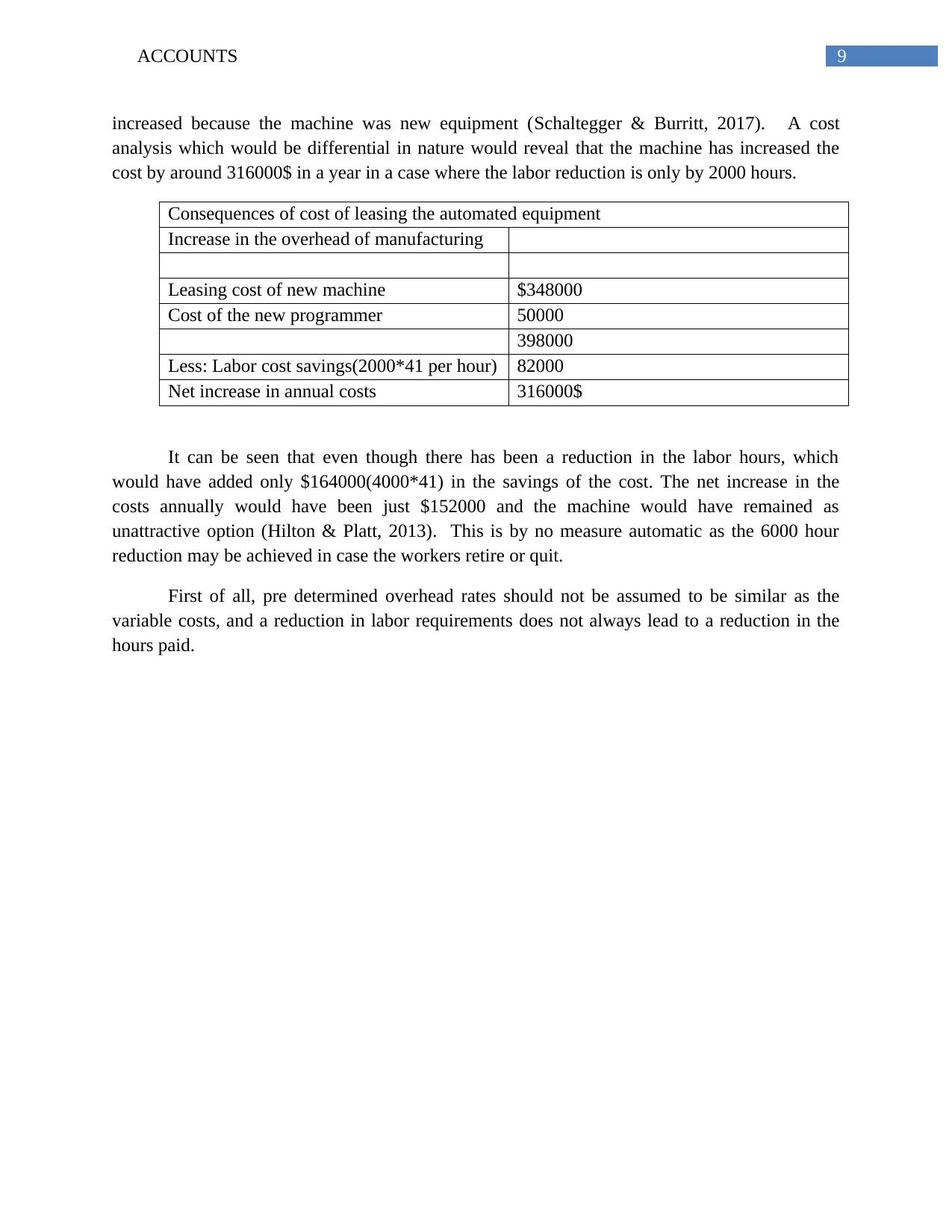
9ACCOUNTS
increased because the machine was new equipment (Schaltegger & Burritt, 2017). A cost
analysis which would be differential in nature would reveal that the machine has increased the
cost by around 316000$ in a year in a case where the labor reduction is only by 2000 hours.
Consequences of cost of leasing the automated equipment
Increase in the overhead of manufacturing
Leasing cost of new machine $348000
Cost of the new programmer 50000
398000
Less: Labor cost savings(2000*41 per hour) 82000
Net increase in annual costs 316000$
It can be seen that even though there has been a reduction in the labor hours, which
would have added only $164000(4000*41) in the savings of the cost. The net increase in the
costs annually would have been just $152000 and the machine would have remained as
unattractive option (Hilton & Platt, 2013). This is by no measure automatic as the 6000 hour
reduction may be achieved in case the workers retire or quit.
First of all, pre determined overhead rates should not be assumed to be similar as the
variable costs, and a reduction in labor requirements does not always lead to a reduction in the
hours paid.
increased because the machine was new equipment (Schaltegger & Burritt, 2017). A cost
analysis which would be differential in nature would reveal that the machine has increased the
cost by around 316000$ in a year in a case where the labor reduction is only by 2000 hours.
Consequences of cost of leasing the automated equipment
Increase in the overhead of manufacturing
Leasing cost of new machine $348000
Cost of the new programmer 50000
398000
Less: Labor cost savings(2000*41 per hour) 82000
Net increase in annual costs 316000$
It can be seen that even though there has been a reduction in the labor hours, which
would have added only $164000(4000*41) in the savings of the cost. The net increase in the
costs annually would have been just $152000 and the machine would have remained as
unattractive option (Hilton & Platt, 2013). This is by no measure automatic as the 6000 hour
reduction may be achieved in case the workers retire or quit.
First of all, pre determined overhead rates should not be assumed to be similar as the
variable costs, and a reduction in labor requirements does not always lead to a reduction in the
hours paid.
Paraphrase This Document
Need a fresh take? Get an instant paraphrase of this document with our AI Paraphraser
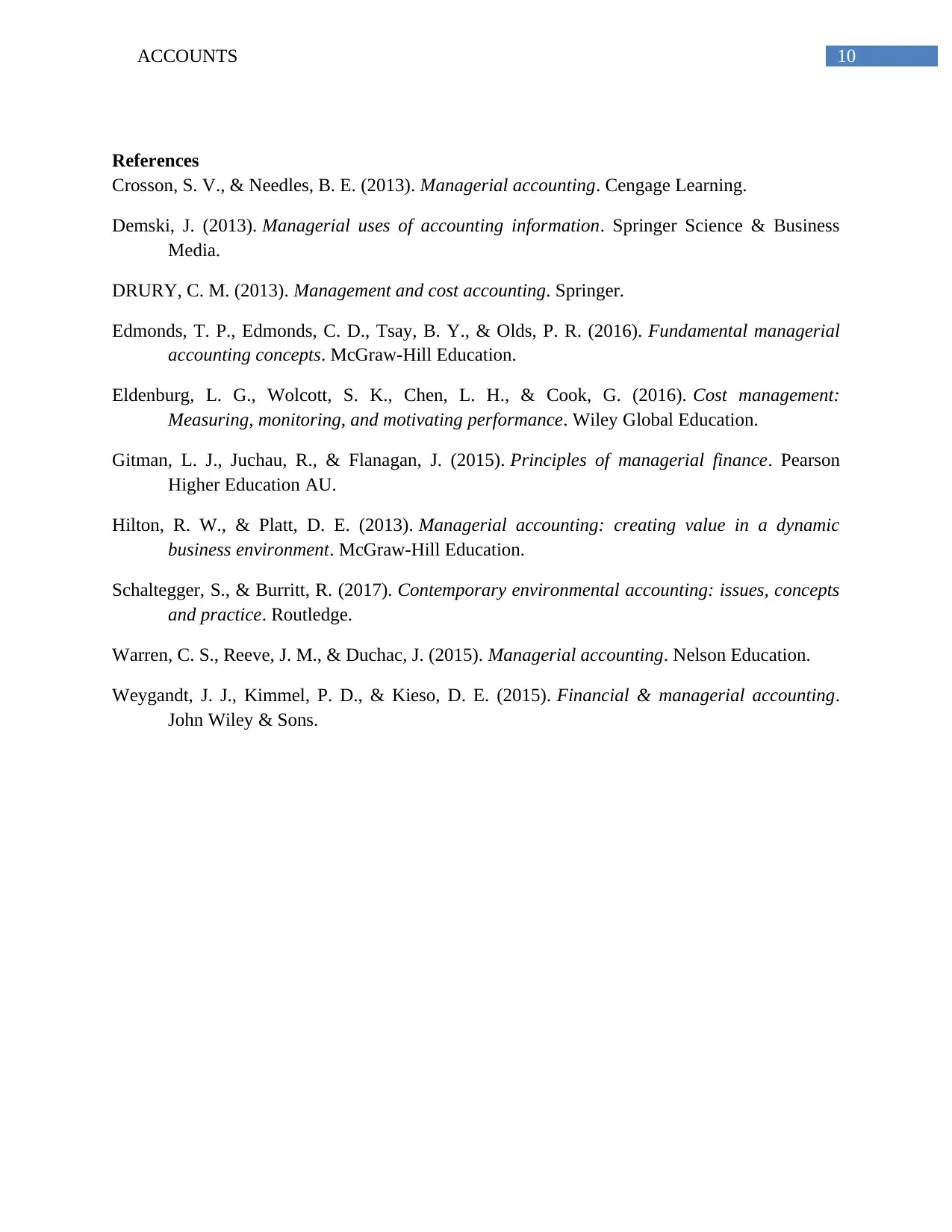
10ACCOUNTS
References
Crosson, S. V., & Needles, B. E. (2013). Managerial accounting. Cengage Learning.
Demski, J. (2013). Managerial uses of accounting information. Springer Science & Business
Media.
DRURY, C. M. (2013). Management and cost accounting. Springer.
Edmonds, T. P., Edmonds, C. D., Tsay, B. Y., & Olds, P. R. (2016). Fundamental managerial
accounting concepts. McGraw-Hill Education.
Eldenburg, L. G., Wolcott, S. K., Chen, L. H., & Cook, G. (2016). Cost management:
Measuring, monitoring, and motivating performance. Wiley Global Education.
Gitman, L. J., Juchau, R., & Flanagan, J. (2015). Principles of managerial finance. Pearson
Higher Education AU.
Hilton, R. W., & Platt, D. E. (2013). Managerial accounting: creating value in a dynamic
business environment. McGraw-Hill Education.
Schaltegger, S., & Burritt, R. (2017). Contemporary environmental accounting: issues, concepts
and practice. Routledge.
Warren, C. S., Reeve, J. M., & Duchac, J. (2015). Managerial accounting. Nelson Education.
Weygandt, J. J., Kimmel, P. D., & Kieso, D. E. (2015). Financial & managerial accounting.
John Wiley & Sons.
References
Crosson, S. V., & Needles, B. E. (2013). Managerial accounting. Cengage Learning.
Demski, J. (2013). Managerial uses of accounting information. Springer Science & Business
Media.
DRURY, C. M. (2013). Management and cost accounting. Springer.
Edmonds, T. P., Edmonds, C. D., Tsay, B. Y., & Olds, P. R. (2016). Fundamental managerial
accounting concepts. McGraw-Hill Education.
Eldenburg, L. G., Wolcott, S. K., Chen, L. H., & Cook, G. (2016). Cost management:
Measuring, monitoring, and motivating performance. Wiley Global Education.
Gitman, L. J., Juchau, R., & Flanagan, J. (2015). Principles of managerial finance. Pearson
Higher Education AU.
Hilton, R. W., & Platt, D. E. (2013). Managerial accounting: creating value in a dynamic
business environment. McGraw-Hill Education.
Schaltegger, S., & Burritt, R. (2017). Contemporary environmental accounting: issues, concepts
and practice. Routledge.
Warren, C. S., Reeve, J. M., & Duchac, J. (2015). Managerial accounting. Nelson Education.
Weygandt, J. J., Kimmel, P. D., & Kieso, D. E. (2015). Financial & managerial accounting.
John Wiley & Sons.
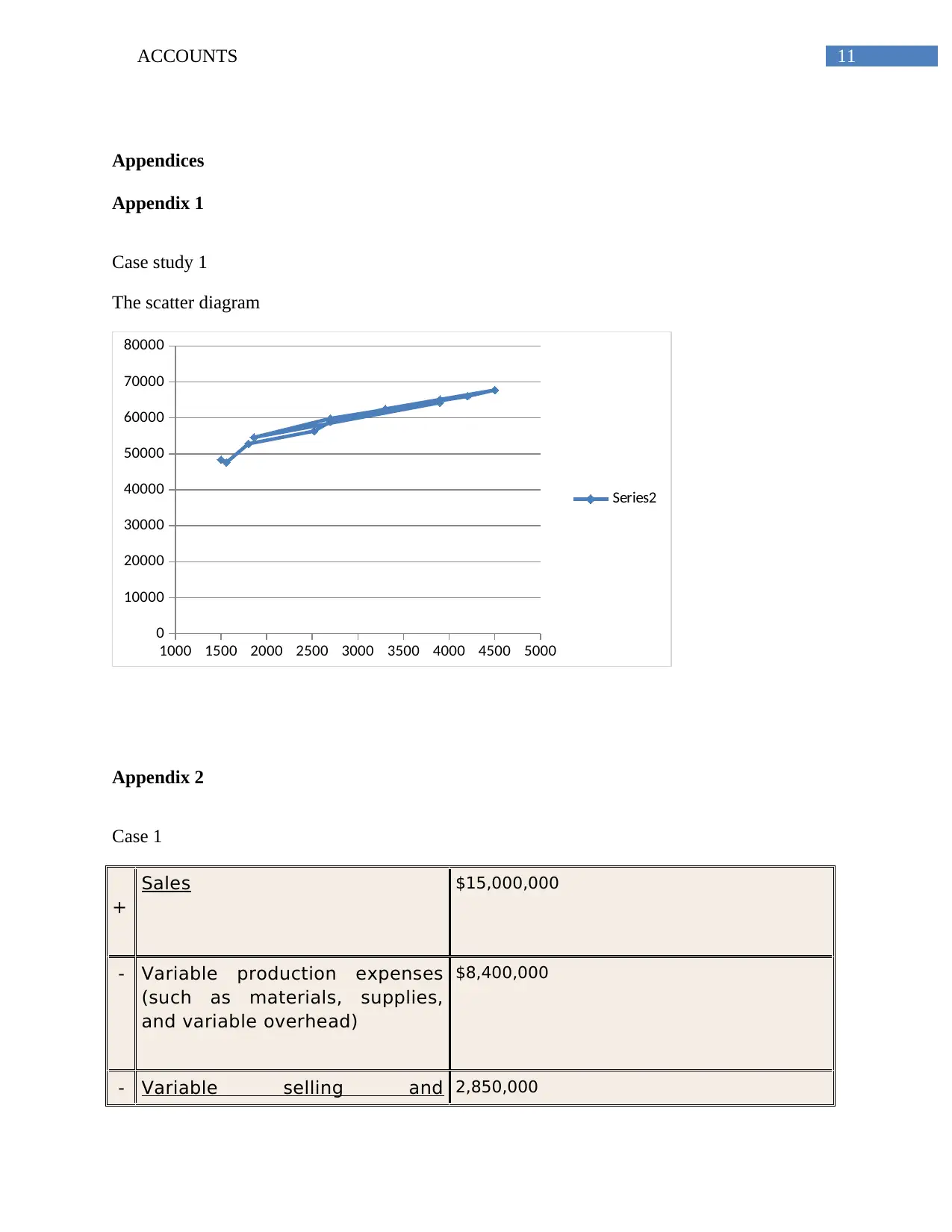
11ACCOUNTS
Appendices
Appendix 1
Case study 1
The scatter diagram
1000 1500 2000 2500 3000 3500 4000 4500 5000
0
10000
20000
30000
40000
50000
60000
70000
80000
Series2
Appendix 2
Case 1
+
Sales $15,000,000
- Variable production expenses
(such as materials, supplies,
and variable overhead)
$8,400,000
- Variable selling and 2,850,000
Appendices
Appendix 1
Case study 1
The scatter diagram
1000 1500 2000 2500 3000 3500 4000 4500 5000
0
10000
20000
30000
40000
50000
60000
70000
80000
Series2
Appendix 2
Case 1
+
Sales $15,000,000
- Variable production expenses
(such as materials, supplies,
and variable overhead)
$8,400,000
- Variable selling and 2,850,000
⊘ This is a preview!⊘
Do you want full access?
Subscribe today to unlock all pages.

Trusted by 1+ million students worldwide
1 out of 15
Related Documents
Your All-in-One AI-Powered Toolkit for Academic Success.
+13062052269
info@desklib.com
Available 24*7 on WhatsApp / Email
![[object Object]](/_next/static/media/star-bottom.7253800d.svg)
Unlock your academic potential
Copyright © 2020–2025 A2Z Services. All Rights Reserved. Developed and managed by ZUCOL.



